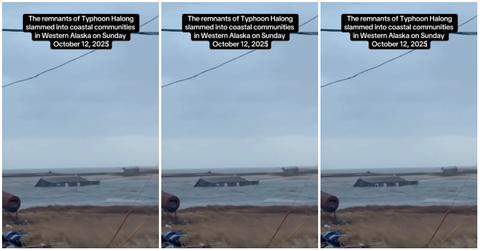Rescue Missions Are Underway as a Devastating Typhoon Hits Alaska
Winds reached as high as 100 miles per hour during the height of the storm.
Published Oct. 13 2025, 12:51 p.m. ET

When you think of typhons, you may think of tropical locations. However, typhoons — which is the name given to tropical cyclones that occur in the waters of the West Pacific, according to NASA — can make landfall in territories of the U.S. (like Mariana Islands a Guam), they aren't a major threat to the contiguous U.S.
However, that means they can make landfall in Alaska, which can prove devastating for the state's coastal areas.
An October 2025 typhoon proved just how dangerous it can be, as typhoons hit Alaska after Typhoon Halong hammered the coast of western Alaska. Storm surges were fueled by intense winds that reached triple digits, according to experts, and several villages experienced such severe flooding that homes were washed away.
You can learn more about the typhoon below, including what local politicians say will happen to the hardest hit regions of the state.

A typhoon hit Alaska during the weekend of Oct. 10, 2025.
According to The Weather Channel, the western side of Alaska — which is surrounded by the chilly waters of the Bering Sea — was pounded by the remnants of Typhoon Halong. It sounds like coastal villages, like Bethel, Kotzebue, Kipnuk, Kwigillingok, and Nome, were especially hard hit by the storm.
According to Wikipedia, Halong was a Cat. 4 typhoon, and it traveled past the coast of Japan before hammering the Alaskan coast, where it was likely a Cat. 1 or 2 storm.
Typhoons are ranked similarly to hurricanes, and the Saffir-Simpson scale is used to put them into categories that range from Tropical Depressions all the way up to a Category 5 storm.
As a Cat. 4, this typhoon would've been capable of producing winds that range from 130-156 miles per hour. Those winds likely helped power the storm surges that crushed the coast, and led to the devastation that produced the massive wind gusts that were felt by Alaskans as the storm battered the region.
Alaska experienced devastating flooding as a result of typhoon.
Typhoon Halong produced such heavy rains that severe flooding occurred, according to CNN, which saw multiple homes swept from their foundations. Rescue operations were also underway as of Oct. 13, 2025, as several towns reported their missing.
In Kwigillingok, three people remained missing when the sun rose on Monday, and authorities believe that there will be more cases reported as the water starts to recede and residents assess the damage and check on their friends and neighbors.
CNN says that the water levels rose 14.5 in Kipnuk, which is two feet above what the area considers a "major flood stage." That number broke the most recent record flood levels that were reached in 2000 by 1.5 feet.
Alaska's Dan Sullivan shared an update on X about the situation, sharing how he had been working closely with FEMA and the department of Homeland Security to get search and rescue efforts off the ground, and so that they can access the damage from the storm.